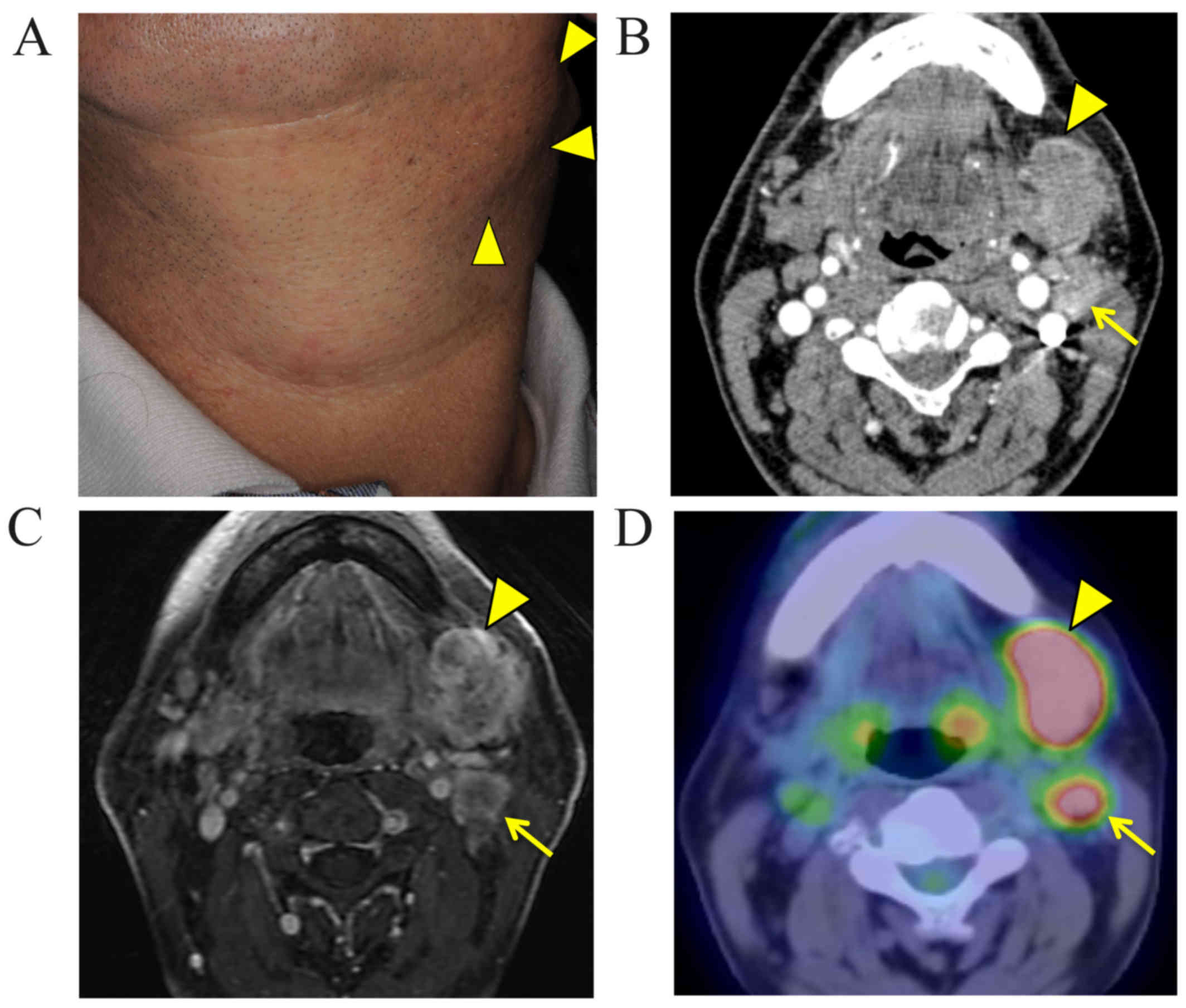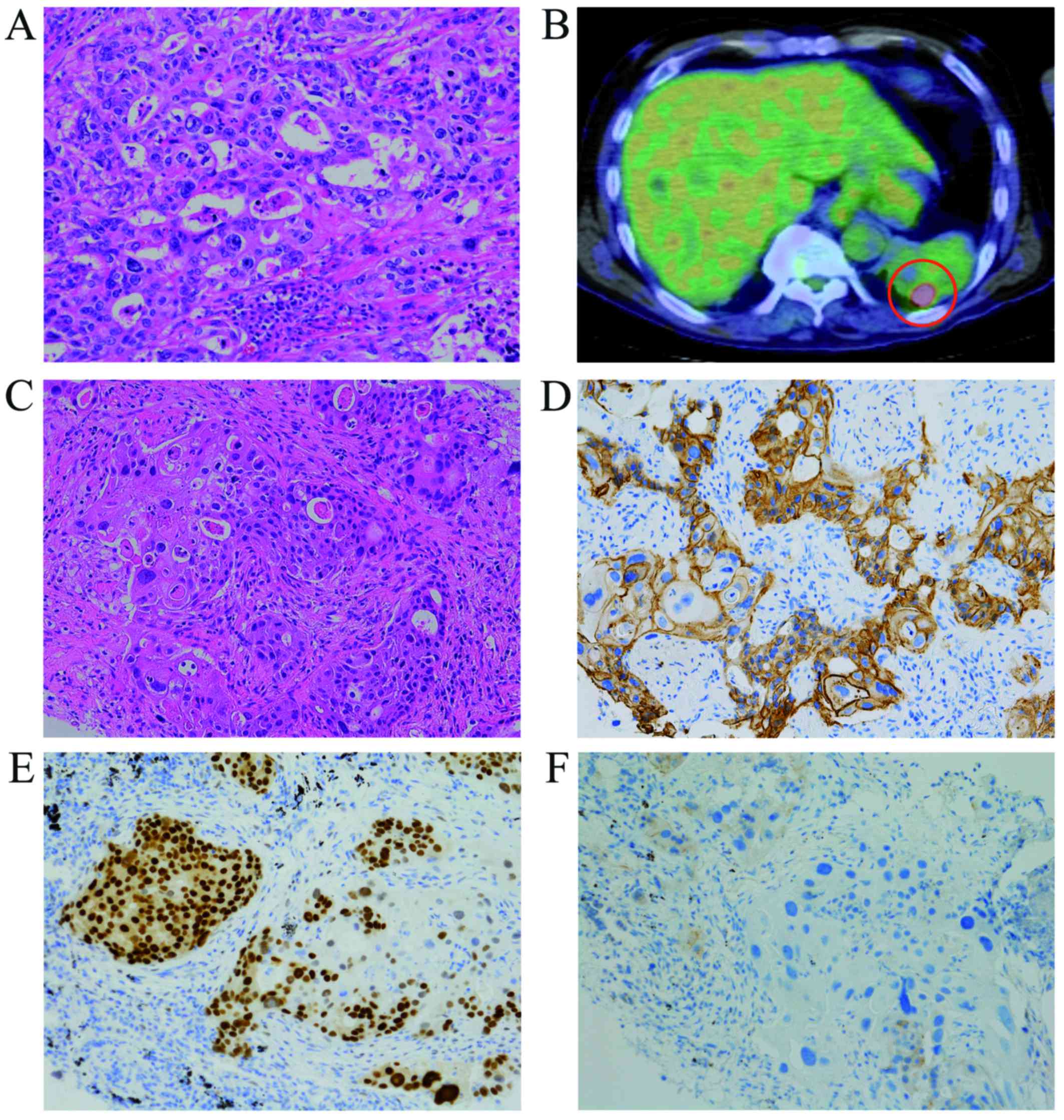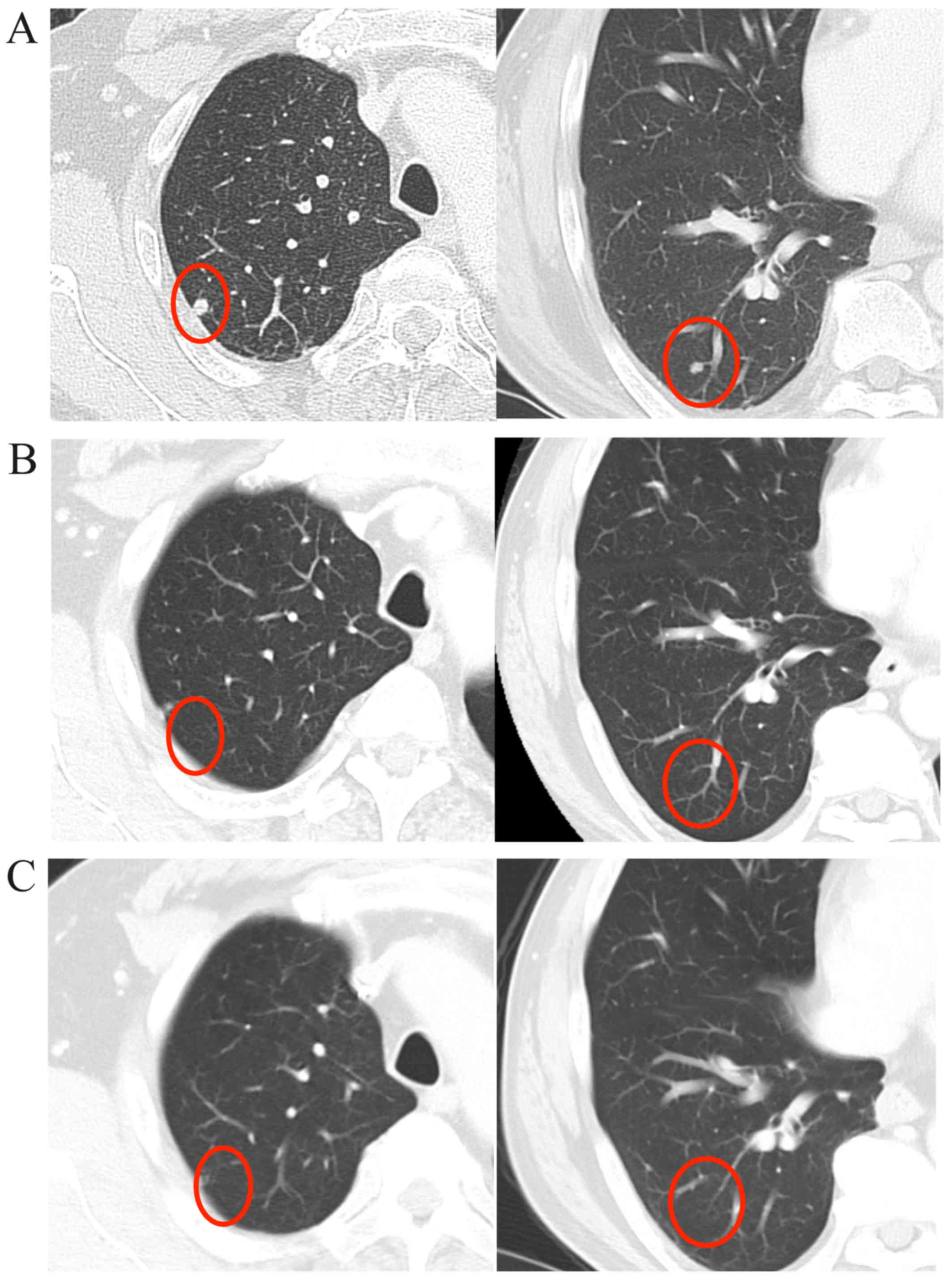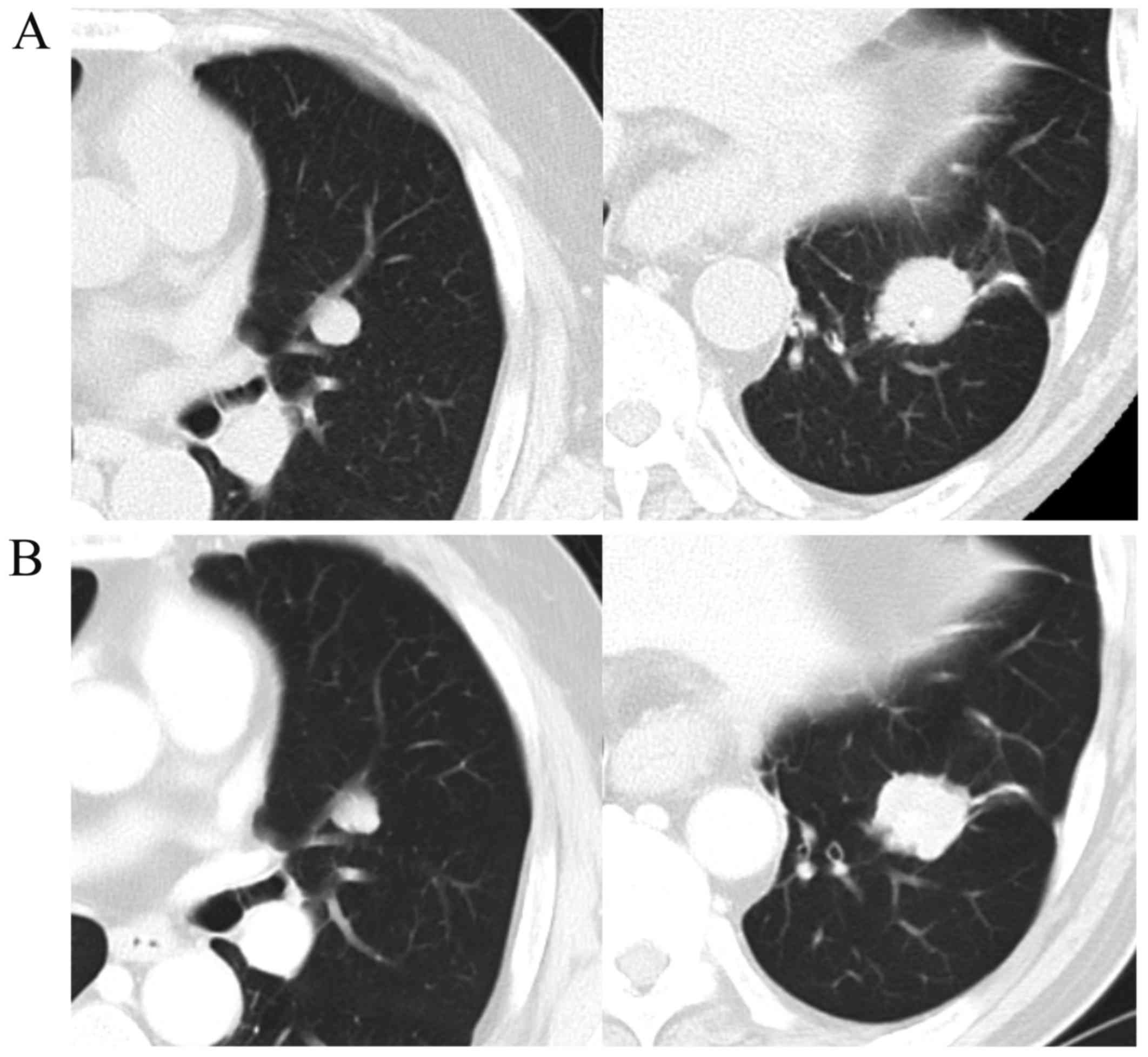|
1
|
Gal R, Strauss M, Zohar Y and Kessler E:
Salivary duct carcinoma of the parotid gland. Cytologic and
histopathologic study. Acta Cytol. 29:454–456. 1985.PubMed/NCBI
|
|
2
|
Jaehne M, Roeser K, Jaekel T, Schepers JD,
Albert N and Löning T: Clinical and immunohistologic typing of
salivary duct carcinoma: A report of 50 cases. Cancer.
103:2526–2533. 2005. View Article : Google Scholar : PubMed/NCBI
|
|
3
|
Seifert G, Batsakis J, Brocheriou C,
Cardesa A, Dardick I and Ellis G: World Health Organization.
Histological typing of salivary gland tumors. 2nd. New York:
Springer; 1991, View Article : Google Scholar
|
|
4
|
Seifert G and Caselitz J: Epithelial
salivary gland tumors: Tumor markersFenoglio-Preiser CM, Wolff M
and Rilke F: Progress in surgical pathology. New York: Field &
Wood; pp. 157–187. 1989, View Article : Google Scholar
|
|
5
|
Barnes L, Eveson J, Reichart P and
Sidranksky D: World Health Organization Classification of
TumoursPathology and genetics of head and neck tumours. Lyon: IARC
Press; pp. 236–237. 2005
|
|
6
|
McHugh JB, Visscher DW and Barnes EL:
Update on selected salivary gland neoplasms. Arch Pathol Lab Med.
133:1763–1774. 2009.PubMed/NCBI
|
|
7
|
Shinoto M, Shioyama Y, Nakamura K,
Nakashima T, Kunitake N, Higaki Y, Sasaki T, Ohga S, Yoshitake T,
Ohnishi K, et al: Postoperative radiotherapy in patients with
salivary duct carcinoma: Clinical outcomes and prognostic factors.
J Radiat Res. 54:925–930. 2013. View Article : Google Scholar : PubMed/NCBI
|
|
8
|
Kim JY, Lee S, Cho KJ, Kim SY, Nam SY,
Choi SH, Roh JL, Choi EK, Kim JH, Song SY, et al: Treatment results
of post-operative radiotherapy in patients with salivary duct
carcinoma of the major salivary glands. Br J Radiol. 85:e947–e952.
2012. View Article : Google Scholar : PubMed/NCBI
|
|
9
|
Johnston ML, Huang SH, Waldron JN, Atenafu
EG, Chan K, Cummings BJ, Gilbert RW, Goldstein D, Gullane PJ, Irish
JC, et al: Salivary duct carcinoma: Treatment, outcomes, and
patterns of failure. Head Neck. 8 Suppl 1:E820–E826. 2016.
View Article : Google Scholar
|
|
10
|
Salovaara E, Hakala O, Bäck L, Koivunen P,
Saarilahti K, Passador-Santos F, Leivo I and Mäkitie AA: Management
and outcome of salivary duct carcinoma in major salivary glands.
Eur Arch Otorhinolaryngol. 270:281–285. 2013. View Article : Google Scholar : PubMed/NCBI
|
|
11
|
Weon YC, Park SW, Kim HJ, Jeong HS, Ko YH,
Park IS, Kim ST, Baek CH and Son YI: Salivary duct carcinomas:
Clinical and CT and MR imaging features in 20 patients.
Neuroradiology. 54:631–640. 2012. View Article : Google Scholar : PubMed/NCBI
|
|
12
|
Roh JL, Cho KJ, Kwon GY, Choi SH, Nam SY
and Kim SY: Prognostic values of pathologic findings and hypoxia
markers in 21 patients with salivary duct carcinoma. J Surg Oncol.
97:596–600. 2008. View Article : Google Scholar : PubMed/NCBI
|
|
13
|
Falchook GS, Lippman SM, Bastida CC and
Kurzrock R: Human epidermal receptor 2-amplified salivary duct
carcinoma: Regression with dual human epidermal receptor 2
inhibition and anti-vascular endothelial growth factor combination
treatment. Head Neck. 36:E25–E27. 2014. View Article : Google Scholar : PubMed/NCBI
|
|
14
|
Xie S, Yang H, Bredell M, Shen S, Yang H,
Jin L and Zhang S: Salivary duct carcinoma of the parotid gland: A
case report and review of the literature. Oncol Lett. 9:371–374.
2015.PubMed/NCBI
|
|
15
|
Lee JS, Kwon OJ, Park JJ and Seo JH:
Salivary duct carcinoma of the parotid gland: Is adjuvant
HER-2-targeted therapy required? J Oral Maxillofac Surg.
72:1023–1031. 2014. View Article : Google Scholar : PubMed/NCBI
|
|
16
|
Limaye SA, Posner MR, Krane JF, Fonfria M,
Lorch JH, Dillon DA, Shreenivas AV, Tishler RB and Haddad RI:
Trastuzumab for the treatment of salivary duct carcinoma.
Oncologist. 18:294–300. 2013. View Article : Google Scholar : PubMed/NCBI
|
|
17
|
Fan CY, Melhem MF, Hosal AS, Grandis JR
and Barnes EL: Expression of androgen receptor, epidermal growth
factor receptor, and transforming growth factor alpha in salivary
duct carcinoma. Arch Otolaryngol Head Neck Surg. 127:1075–1079.
2001. View Article : Google Scholar : PubMed/NCBI
|
|
18
|
Williams MD, Roberts D, Blumenschein GR
Jr, Temam S, Kies MS, Rosenthal DI, Weber RS and El-Naggar AK:
Differential expression of hormonal and growth factor receptors in
salivary duct carcinomas: Biologic significance and potential role
in therapeutic stratification of patients. Am J Surg Path.
31:1645–1652. 2007. View Article : Google Scholar : PubMed/NCBI
|
|
19
|
Williams MD, Roberts DB, Kies MS, Mao L,
Weber RS and El-Naggar AK: Genetic and expression analysis of HER-2
and EGFR genes in salivary duct carcinoma: Empirical and
therapeutic significance. Clin Cancer Res. 16:2266–2274. 2010.
View Article : Google Scholar : PubMed/NCBI
|
|
20
|
Locati LD, Bossi P, Perrone F, Potepan P,
Crippa F, Mariani L, Casieri P, Orsenigo M, Losa M, Bergamini C, et
al: Cetuximab in recurrent and/or metastatic salivary gland
carcinomas: A phase II study. Oral Oncol. 45:574–578. 2009.
View Article : Google Scholar : PubMed/NCBI
|
|
21
|
Seifert G, Brocheriou C, Cardesa A and
Eveson JW: WHO International histological classification of
tumours. Tentative histological classification of salivary gland
tumours. Pathol Res Pract. 186:555–581. 1990. View Article : Google Scholar : PubMed/NCBI
|
|
22
|
Vermorken JB, Mesia R, Rivera F, Remenar
E, Kawecki A, Rottey S, Rottey S, Erfan J, Zabolotnyy D, Kienzer
HR, et al: Platinum-based chemotherapy plus cetuximab in head and
neck cancer. New Engl J Med. 359:1116–1127. 2008. View Article : Google Scholar : PubMed/NCBI
|
|
23
|
Guo Y, Shi M, Yang A, Feng J, Zhu X, Choi
YJ, Hu G, Pan J, Hu C, Luo R, et al: Platinum-based chemotherapy
plus cetuximab first-line for Asian patients with recurrent and/or
metastatic squamous cell carcinoma of the head and neck: Results of
an open-label, single-arm, multicenter trial. Head Neck.
37:1081–1087. 2015. View Article : Google Scholar : PubMed/NCBI
|
|
24
|
Tsukahara K, Kubota A, Hasegawa Y,
Takemura H, Terada T, Taguchi T, Nagahara K, Nakatani H, Yoshino K,
Higaki Y, et al: Randomized phase III trial of adjuvant
chemotherapy with S-1 after curative treatment in patients with
squamous-cell carcinoma of the head and neck (ACTS-HNC). PLoS One.
10:e01169652015. View Article : Google Scholar : PubMed/NCBI
|
|
25
|
Kleinsasser O, Klein HJ and Hubner G:
Salivary duct carcinoma. A group of salivary gland tumors analogous
to mammary duct carcinoma. Arch Klin Exp Ohren Nasen
Kehlkopfheilkd. 192:100–105. 1968.(In German). View Article : Google Scholar : PubMed/NCBI
|
|
26
|
Adelstein DJ, Koyfman SA, El-Naggar AK and
Hanna EY: Biology and management of salivary gland cancers. Semin
Radiat Oncol. 22:245–253. 2012. View Article : Google Scholar : PubMed/NCBI
|
|
27
|
Barnes L, Rao U, Krause J, Contis L,
Schwartz A and Scalamogna P: Salivary duct carcinoma. Part I. A
clinicopathologic evaluation and DNA image analysis of 13 cases
with review of the literature. Oral Surg Oral Med Oral Pathol.
78:64–73. 1994. View Article : Google Scholar : PubMed/NCBI
|
|
28
|
Guzzo M, Di Palma S, Grandi C and Molinari
R: Salivary duct carcinoma: Clinical characteristics and treatment
strategies. Head Neck. 19:126–133. 1997. View Article : Google Scholar : PubMed/NCBI
|
|
29
|
Airoldi M, Fornari G, Pedani F,
Marchionatti S, Gabriele P, Succo G and Bumma C: Paclitaxel and
carboplatin for recurrent salivary gland malignancies. Anticancer
Res. 20:3781–3783. 2000.PubMed/NCBI
|
|
30
|
Surakanti SG and Agulnik M: Salivary gland
malignancies: The role for chemotherapy and molecular targeted
agents. Semin Oncol. 35:309–319. 2008. View Article : Google Scholar : PubMed/NCBI
|
|
31
|
Dimery IW, Legha SS, Shirinian M and Hong
WK: Fluorouracil, doxorubicin, cyclophosphamide, and cisplatin
combination chemotherapy in advanced or recurrent salivary gland
carcinoma. J Clin Oncol. 8:1056–1062. 1990. View Article : Google Scholar : PubMed/NCBI
|
|
32
|
Lagha A, Chraiet N, Ayadi M, Krimi S,
Allani B, Rifi H, Raies H and Mezlini A: Systemic therapy in the
management of metastatic or advanced salivary gland cancers. Oral
Oncol. 48:948–957. 2012. View Article : Google Scholar : PubMed/NCBI
|
|
33
|
Bobbio A, Copelli C, Ampollini L, Bianchi
B, Carbognani P, Bettati S, Sesenna E and Rusca M: Lung metastasis
resection of adenoid cystic carcinoma of salivary glands. Eur J
Cardiothorac Surg. 33:790–793. 2008. View Article : Google Scholar : PubMed/NCBI
|
|
34
|
Liu D, Labow DM, Dang N, Martini N, Bains
M, Burt M, Downey R Jr, Rusch V, Shah J and Ginsberg RJ: Pulmonary
metastasectomy for head and neck cancers. Ann Surg Oncol.
6:572–578. 1999. View Article : Google Scholar : PubMed/NCBI
|
|
35
|
Kaidar-Person O, Billan S and Kuten A:
Targeted therapy with trastuzumab for advanced salivary ductal
carcinoma: Case report and literature review. Med Oncol.
29:704–706. 2012. View Article : Google Scholar : PubMed/NCBI
|
|
36
|
Nabili V, Tan JW, Bhuta S, Sercarz JA and
Head CS: Salivary duct carcinoma: A clinical and histologic review
with implications for trastuzumab therapy. Head Neck. 29:907–912.
2007. View Article : Google Scholar : PubMed/NCBI
|
|
37
|
Prat A, Parera M, Reyes V, Peralta S,
Cedrés S, Andreu J, Huguet P and del Campo JM: Successful treatment
of pulmonary metastatic salivary ductal carcinoma with
trastuzumab-based therapy. Head Neck. 30:680–683. 2008. View Article : Google Scholar : PubMed/NCBI
|
|
38
|
Ettl T, Stiegler C, Zeitler K, Agaimy A,
Zenk J, Reichert TE, Gosau M, Kühnel T, Brockhoff G and Schwarz S:
EGFR, HER2, survivin, and loss of pSTAT3 characterize high-grade
malignancy in salivary gland cancer with impact on prognosis. Hum
Pathol. 43:921–931. 2012. View Article : Google Scholar : PubMed/NCBI
|
|
39
|
Ito FA, Ito K, Coletta RD, Graner E, de
Almeida OP and Lopes MA: Salivary gland tumors: Immunohistochemical
study of EGF EGFR, ErbB-2, FAS and Ki-67. Anal Quant Cytol Histol.
31:280–287. 2009.PubMed/NCBI
|













